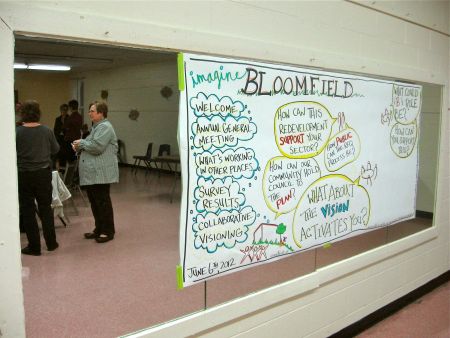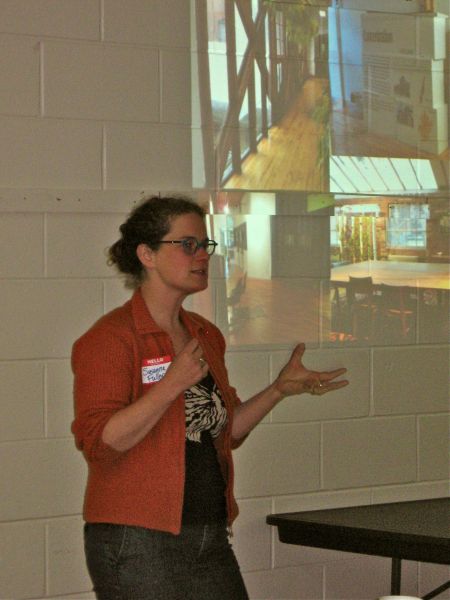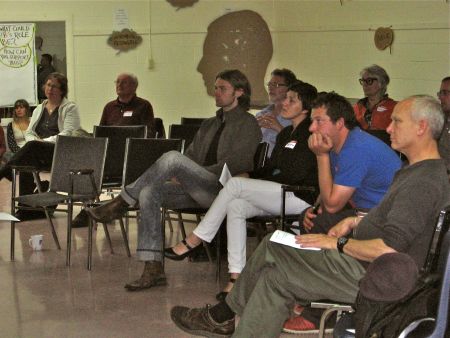Imagine Bloomfield wants more than a community centre; it wants to set a new tone for future development in Halifax.
“We need to change the discourse around development in this city,” says Imagine Bloomfield co-chair Susanna Fuller. “It needs to be people articulating what they do want and working for it, as opposed to reacting constantly to what they don’t want.”
Imagine Bloomfield has been fighting for the redevelopment of the Bloomfield Centre into a multi-purpose, multi-tenant North End hub for nearly eight years. Their battle hasn’t been fought with posters and protests, however. Instead, the non-profit group has taken an active role in determining what the future Bloomfield Centre will look like, how it will be built, and who will have access to it.
In 2007, the group engaged Dalhousie University Masters in Planning students to conduct a redevelopment feasibility study. The following year, Imagine Bloomfield worked with local architects to draft a master plan for the site. In 2010, the plan was approved unanimously by city council.
Fuller says that while Imagine Bloomfield accepted the basic principles of the plan, the group found it premature to commit to a layout of the centre without knowing who its tenants were and what they would need.
So, Imagine Bloomfield conducted a series of Tenancy & Partnership Surveys in April to do explore just that. Non-profits, community groups, businesses, and individuals looking for housing or workspace detailed how much square footage they require, how many employees and volunteers they have, and what their basic needs are.
At a public meeting Wednesday night to discuss the next steps in making the new Bloomfield Centre a reality, Imagine Bloomfield presented the summary results of the 125 responses they received (see file below). The common themes reflected deficiencies in the city’s existing community services: “There’s not a lot of opportunities for low-cost meeting space and low-cost gyms,” said Imagine Bloomfield co-chair Natalie Chavarie while presenting the results. “There’s a desperate need for studio space in the city,” added survey consultant Adam Barnett. Other recurring demands included bicycle and car parking, accessibility and storage. What stood out the most, however, was the desire and willingness to share space.
Fuller says this idea of sharing translates to the development of the site, which will inevitably include a range of governmental, private and non-profit groups, and such partnership should be reflected in the selection of a developer: “We’re looking for open-minded, creative developers who have done multi-partner developments in the past,” she says. “We want developers who see the benefits of partnership.”
HRM Planning and Infrastructure will be basing its decision, at least in part, on these qualities, explained city staffer Holly Richardson at the Wednesday meeting. A request for qualifications (RFQ) going out as early as next week will seek developers with experience in building community centres with strong non-profit tenancies, as well as working in partnerships, she said.
Once qualified candidates are chosen, they will be presented with both the master plan and the survey results. Richardson said their proposals (RFPs) will be rated on their adherence to the plan’s principles of inclusive, community building, accessible, creative, engaging, adaptable, beautiful, public, environmentally responsible and culturally authentic, not to mention their ideas for potential partners.
This careful consideration of community input is virtually unheard of in the Halifax development world. Fuller says it’s the result of years of building trust and rapport with people at the provincial, municipal and community levels.
Still, the request for qualifications signals the beginning of decision-making behind closed city hall doors — and that made the meeting attendees uneasy.
Several people demanded that Imagine Bloomfield have a say at the table when the RFQs and RFPs were being evaluated. The question got a stammering response by Richardson, followed by Fuller explaining that although that was the group’s original hope, it had since decided that avoiding conflict of interest and observing the process were more important. It also gives Imagine Bloomfield the opportunity to hold the City accountable if decision-making goes awry.
“If a good RFP doesn’t come out of this, then there’s no hope,” she said of a process that everyone in the room agreed had taken longer than need be. HRM Planning and Infrastructure wants to have a developer chosen before municipal elections in October, so that the current council, which has supported the Bloomfield Centre redevelopment, can approve the building proposal.
Meanwhile, as Imagine Bloomfield takes a step back, it’s brainstorming how it will be involved in the centre once the project gets underway: “We’re very seriously thinking about how we transform the organization,” says Fuller. “What’s missing in Halifax is people who do non-profit-based management and programming, so we’re looking at how we transform into that,” the idea being that Imagine Bloomfield might run the future centre.
Discussion groups following the city staffers’ presentation echoed this idea of Imagine Bloomfield maintaining its role as a leader of this initiative. More than that, people found it to be the responsibility of the organization to document how it went about influencing Halifax development processes, so that this project be a first in the history of community centre design and not the last.
“We feel like this can be an example of changing the tide in terms of how community sees development and gets engaged in development,” says Fuller.





